
Concept explainers
Draw the products formed when cholesterol is treated with each reagent. Indicate the stereochemistry around any stereogenic centers in the product.
a.
b.
c. PCC
d. oleic acid,
e. [1]
(a)
Interpretation: The product formed on treatment of cholesterol with
Concept introduction: In the presence of base, the hydroxyl group loses its proton to form alkoxide. The alkoxide attacks on the carbonyl carbon of acyl chloride or anhydride to leading to the formation of acyl group and removal of chloride. This process is known as acylation.
Answer to Problem 31.28P
The product formed on treatment of cholesterol with
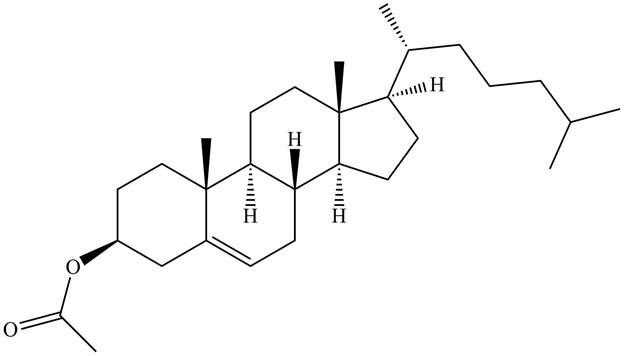
Figure 1
Explanation of Solution
In presence of base and acetyl chloride, the hydroxyl group of cholesterol undergoes acetylation. The corresponding chemical reaction is shown below.

Figure 2
The product formed on treatment of cholesterol with
(b)
Interpretation: The product formed on treatment of cholesterol with
Concept introduction: The addition of
Answer to Problem 31.28P
The product formed on treatment of cholesterol with
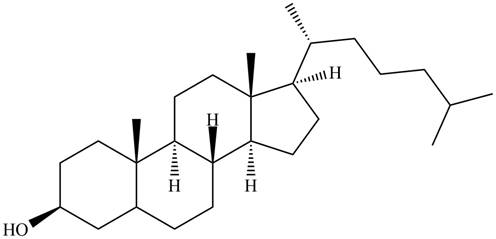
Figure 3
Explanation of Solution
In presence

Figure 4
The product formed on treatment of cholesterol with
(c)
Interpretation: The product formed on treatment of cholesterol with PCC is to be predicted.
Concept introduction: Alcohols are oxidized to different carbonyl compounds depending upon the reagents and alcohol used. In presence of strong oxidizing reagents such as
Answer to Problem 31.28P
The product formed on treatment of cholesterol with PCC is,
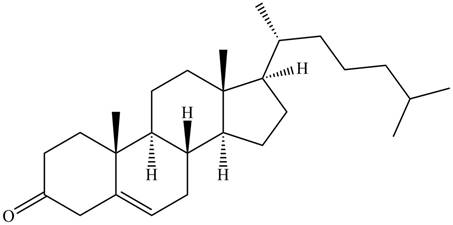
Figure 5
Explanation of Solution
On treatment of cholesterol with PCC, the secondary alcohol is oxidized to ketone. The corresponding chemical reaction is given below

Figure 6
The product formed on treatment of cholesterol with PCC is shown in Figure 5.
(d)
Interpretation: The product formed on treatment of cholesterol with oleic acid,
Concept introduction: In presence of acid, the carboxylic acids are converted to ester using alcohols. This process is known as esterification.
Answer to Problem 31.28P
The product formed on treatment of cholesterol with oleic acid,
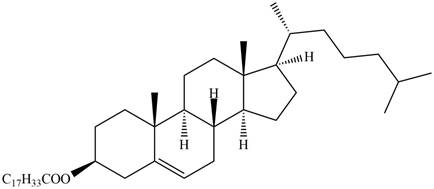
Figure 7
Explanation of Solution
In the presence of acid, the hydroxyl group of cholesterol reacts with oleic acid to form ester. The corresponding chemical reaction is shown below.

Figure 8
The product formed on treatment of cholesterol with oleic acid,
(e)
Interpretation: The product formed on treatment of cholesterol with 1.
Concept introduction: In the presence of borane, hydroperoxide and base the alkenes are converted to alcohols. In this reaction hydrogen atom and hydroxyl groups are added to the double bond. This reaction takes place in anti-markovnikov addition manner. This is a syn addition.
Answer to Problem 31.28P
The product formed on treatment of cholesterol with 1.
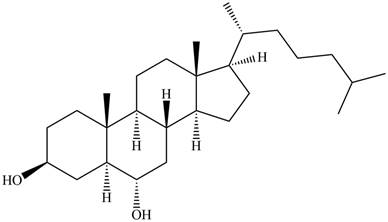
Figure 9
Explanation of Solution
In the presence of borane, hydroperoxide and base the double bond of cholesterol is oxidized to alcohol. The corresponding chemical reaction is shown below.

Figure 10
The product formed on treatment of cholesterol with 1.
Want to see more full solutions like this?
Chapter 31 Solutions
Organic Chemistry
- Decide whether these proposed Lewis structures are reasonable. proposed Lewis structure Is the proposed Lewis structure reasonable? Yes. :0: Cl C C1: 0=0: : 0 : : 0 : H C N No, it has the wrong number of valence electrons. The correct number is: ☐ No, it has the right number of valence electrons but doesn't satisfy the octet rule. The symbols of the problem atoms are:* ☐ Yes. No, it has the wrong number of valence electrons. The correct number is: ☐ No, it has the right number of valence electrons but doesn't satisfy the octet rule. The symbols of the problem atoms are:* Yes. ☐ No, it has the wrong number of valence electrons. The correct number is: ☐ No, it has the right number of valence electrons but doesn't satisfy the octet rule. The symbols of the problem atoms are:* | * If two or more atoms of the same element don't satisfy the octet rule, just enter the chemical symbol as many times as necessary. For example, if two oxygen atoms don't satisfy the octet rule, enter "0,0".arrow_forwardDraw the Lewis structure for the polyatomic trisulfide anion. Be sure to include all resonance structures that satisfy the octet rule. с [ ] - Garrow_forward1. Calculate the accurate monoisotopic mass (using all 1H, 12C, 14N, 160 and 35CI) for your product using the table in your lab manual. Don't include the Cl, since you should only have [M+H]*. Compare this to the value you see on the LC-MS printout. How much different are they? 2. There are four isotopic peaks for the [M+H]* ion at m/z 240, 241, 242 and 243. For one point of extra credit, explain what each of these is and why they are present. 3. There is a fragment ion at m/z 184. For one point of extra credit, identify this fragment and confirm by calculating the accurate monoisotopic mass. 4. The UV spectrum is also at the bottom of your printout. For one point of extra credit, look up the UV spectrum of bupropion on Google Images and compare to your spectrum. Do they match? Cite your source. 5. For most of you, there will be a second chromatographic peak whose m/z is 74 (to a round number). For one point of extra credit, see if you can identify this molecule as well and confirm by…arrow_forward
- Please draw, not just describe!arrow_forwardcan you draw each step on a piece of a paper please this is very confusing to mearrow_forward> Can the molecule on the right-hand side of this organic reaction be made in good yield from no more than two reactants, in one step, by moderately heating the reactants? esc ? A O O •If your answer is yes, then draw the reactant or reactants in the drawing area below. You can draw the reactants in any arrangement you like. • If your answer is no, check the box under the drawing area instead. olo 18 Ar Explanation Check BB Click and drag to start drawing a structure. 2025 McGraw Hill LLC. All Rights Reserved. Terms of Use | Privacy Center Accessibilityarrow_forward
- Name the structurearrow_forward> For each pair of substrates below, choose the one that will react faster in a substitution reaction, assuming that: 1. the rate of substitution doesn't depend on nucleophile concentration and 2. the products are a roughly 50/50 mixture of enantiomers. Substrate A Substrate B Faster Rate X CI (Choose one) (Choose one) CI Br Explanation Check Br (Choose one) C 2025 McGraw Hill LLC. All Rights Reserved. Terms of Use | Privacy A F10arrow_forwardHow to draw this mechanism for the foloowing reaction in the foto. thank youarrow_forward
- Predict the major products of the following organic reaction: Some important notes: CN A? • Draw the major product, or products, of the reaction in the drawing area below. • If there aren't any products, because no reaction will take place, check the box below the drawing area instead. • Be sure to use wedge and dash bonds when necessary, for example to distinguish between major products that are enantiomers. No reaction. Explanation Check Click and drag to start drawing a structure. 2025 McGraw Hill LLC. All Rights Reserved. Terms of Use Privacy Centerarrow_forwardDraw the major product of the following reaction. Do not draw inorganic byproducts. H3PO4 OHarrow_forwardPredict the major products of this organic reaction: HBr (1 equiv) Δ ? Some important notes: • Draw the major product, or products, of this reaction in the drawing area below. • You can draw the products in any arrangement you like. • Pay careful attention to the reaction conditions, and only include the major products. • Be sure to use wedge and dash bonds when necessary, for example to distinguish between major products that are enantiomers. • Note that there is only 1 equivalent of HBr reactant, so you need not consider the case of multiple additions. Explanation Check X ©2025 McGraw Hill LLC. All Rights Reserved. Terms of Use | Privacyarrow_forward
 Introduction to General, Organic and BiochemistryChemistryISBN:9781285869759Author:Frederick A. Bettelheim, William H. Brown, Mary K. Campbell, Shawn O. Farrell, Omar TorresPublisher:Cengage Learning
Introduction to General, Organic and BiochemistryChemistryISBN:9781285869759Author:Frederick A. Bettelheim, William H. Brown, Mary K. Campbell, Shawn O. Farrell, Omar TorresPublisher:Cengage Learning
